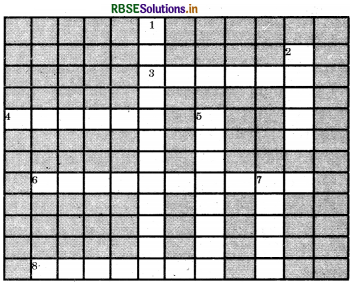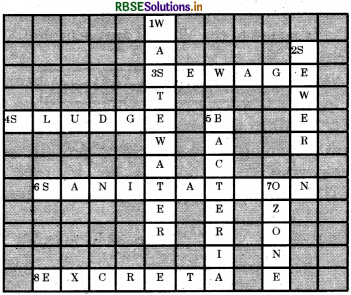RBSE Solutions for Class 7 Science Chapter 18 Wastewater Story
Rajasthan Board RBSE Solutions for Class 7 Science Chapter 18 Wastewater Story Textbook Exercise Questions and Answers.
Rajasthan Board RBSE Solutions for Class 7 Science in Hindi Medium & English Medium are part of RBSE Solutions for Class 7. Students can also read RBSE Class 7 Science Important Questions for exam preparation. Students can also go through RBSE Class 7 Science Notes to understand and remember the concepts easily. The class 7 science chapter 4 heat extra questions are curated with the aim of boosting confidence among students.
RBSE Class 7 Science Solutions Chapter 18 Wastewater Story
RBSE Class 7 Science Wastewater Story InText Questions and Answers
Page 224
Question 1.
The water in a river is cleaned naturally by processes that are similar to those adopted in a wastewater treatment plant.
Answer:
Air passes through the water flowing in the rivers, it works as an aeration process. It helps aerobic bacteria to grow which consumes the organic impurity of wastewater. Soils and rocks present on riverbeds help in sedimentation. Plants and trees provide nutrients. Evaporation of water helps in forming clouds and pure water comes back in the river in the form of rain.

Page 225
Question 2.
Don’t add to the load of WWTP. Paheli wonders how!
Answer:
Normal awareness of every citizen can reduce the load of WWTP. We should not throw the oil, fats, paints, insecticides, medicines, tea leaves, food wastes, cotton into the drain. It can block the sewerage and can hamper the degradation process.
Page 226
Question 3.
Bhoojo wants to know how sewage is disposed off in an aeroplane?
Answer:
The sewerage is collected in a large holding tank through plane’s sewer lines. After landing off the plane, these tanks are transported to the WWTP for treatment of wastewater.
RBSE Class 7 Science Wastewater Story Textbook Questions and Answers
Question 1.
Fill in the blanks
(a) Cleaning of water is a process of removing ....................................
(b) Wastewater released by houses is called ....................................
(c) Dried .................................... is used as manure.
(d) Drains get blocked by .................................... and ....................................
Answer:
(a) pollutants
(b) sewage
(c) sludge
(d) cooking oil and fat.
Question 2.
What is sewage? Explain why it is harmful to discharge untreated sewage into rivers or seas.
Answer:
Sewage is wastewater released by homes, industries, hospitals, and another users. It is contaminated and not fit for use. Sewage contains many organic and inorganic impurities as well as saprotrophic and bacteria causing diseases which are harmful for aquatic life. So it is harmful to discharge untreated sewage into rivers or seas.
Question 3.
Why should oils and fats not be released in the drain? Explain.
Answer:
Oils and fats are not soluble in water and they block the drains. In an open drain, they clog the soil pores, making the filtration process difficult. So, oils and fats should not be released in the drain.
Question 4.
Describe the steps involved in getting clarified water from waste - water.
Answer:
Treatment of wastewater involves physical, chemical and biological processes.
- Wastewater is passed through bar screens to remove large objects like rays, sticks, cans, plastic packets, etc.
- Water is passed to a grit and sand removal tank to allow sand, grit and pebbles to settle down.
- The water is then allowed to large setting tank to permit setting of solid faeces called sludge, which is removed using scraper.
- Air is pumped into the clarified water to help aerobic bacteria to grow and consume the wastes.
- This type of water is discharged into rivers or ponds.
Question 5.
What is sludge? Explain how it is treated?
Answer:
Sludge is a solid like faeces which settle down and removed with a scraper. For the treatment of sludge, it is transferred in a separate tank where it is decomposed by anaerobic bacteria. The biogas is produced in this process and it can be used as a fuel.
Question 6.
Untreated human excreta is a health hazard. Explain.
Answer:
Untreated human excreta make the surrounding unhygienic. This may also lead to water borne diseases like typhoid, hepatitis, cholera, etc.
Question 7.
Name two chemicals used to disinfect water.
Answer:
Chlorine and ozone.
Question 8.
Explain the function of bar screens in a wastewater treatment plant.
Answer:
Bar screens are large filters which are used in wastewater treatment plants to remove large solids like plastic bottles, pebbles, cans, etc. from wastewater.
Question 9.
Explain the relationship between sanitation and disease.
Answer:
Sanitation can be defined as the provision of clean drinking water and an adequate disposal. Lack of sanitation creates unhygienic conditions for humans and breeding ground for microbes. These microbes spread diseases and make people ill. Whereas in case of proper sanitation, chances of diseases are very less. Hence, it can be said that sanitation and diseases are completely related to each other.
Question 10.
Outline your role as an active citizen in relation to sanitation.
Answer:
Good sanitation can only be maintained if every citizen contributes to it. The roles as an active citizen in relation to sanitation are as follows:
- Throwing wastes in dustbin.
- Reporting to municipality if any problem in sewage system.
- By optimum utilization of water.
- Keep the surrounding clean.
- Always keep the sewerage closed and ensuring there is no leakage or any other problem.
- To aware the neighbours about sanitation if it is lacking.

Question 11.
Here is a crossword puzzle: Good luck!

Across
3. Liquid waste products
4. Solid waste extra cted in sewage treatment
6. A word related to hygiene
8. Waste matter discharged from human body
Down
1. Used water
2. A pipe carrying sewage
5. Micro - organisms which causes cholera
7. A chemical to disinfect water
Answer:

Across
3. Sewege
4. Sludge
6. Sanitation
8. Excreta
Down
1. Wastewater
2. Sewer
5. Bacteria
7. Ozone
Question 12.
Study the following statements about ozone:
(a) It is essential for breathing of living organisms.
(b) It is used to disinfect water.
(c) It absorbs ultraviolet rays.
(d) Its proportion in air is about 3%.
Which of these statements are correct?
(i) (a), (b) and (c)
(ii) (b) and (c)
(iii) (a) and (d)
(iv) All of these
Answer:
(ii) (b) and (c).

- RBSE Class 7 Science Notes in Hindi & English Medium Pdf Download
- RBSE Class 7 Science Important Questions in Hindi Medium & English Medium
- RBSE Solutions for Class 7 Science in Hindi Medium & English Medium
- RBSE Class 7 Science Important Questions Chapter 1 Nutrition in Plants
- RBSE Class 7 Science Notes Chapter 1 Nutrition in Plants
- RBSE Class 7 Science Important Questions Chapter 14 Electric Current and its Effects
- RBSE Class 7 Science Important Questions Chapter 13 Motion and Time
- RBSE Class 7 Science Important Questions Chapter 2 Nutrition in Animals
- RBSE Class 6 Science Notes Chapter 8 शरीर में गति
- RBSE Class 7 Science Notes Chapter 18 Wastewater Story
- RBSE Class 7 Science Notes Chapter 17 Forests: Our Lifeline